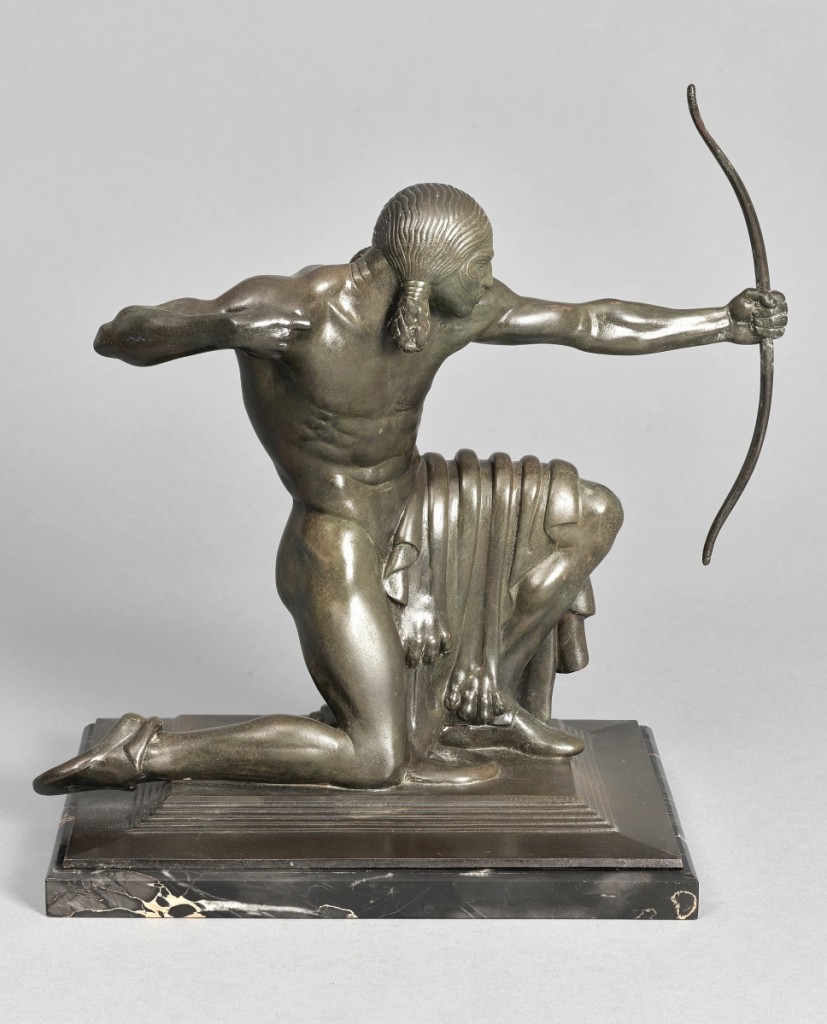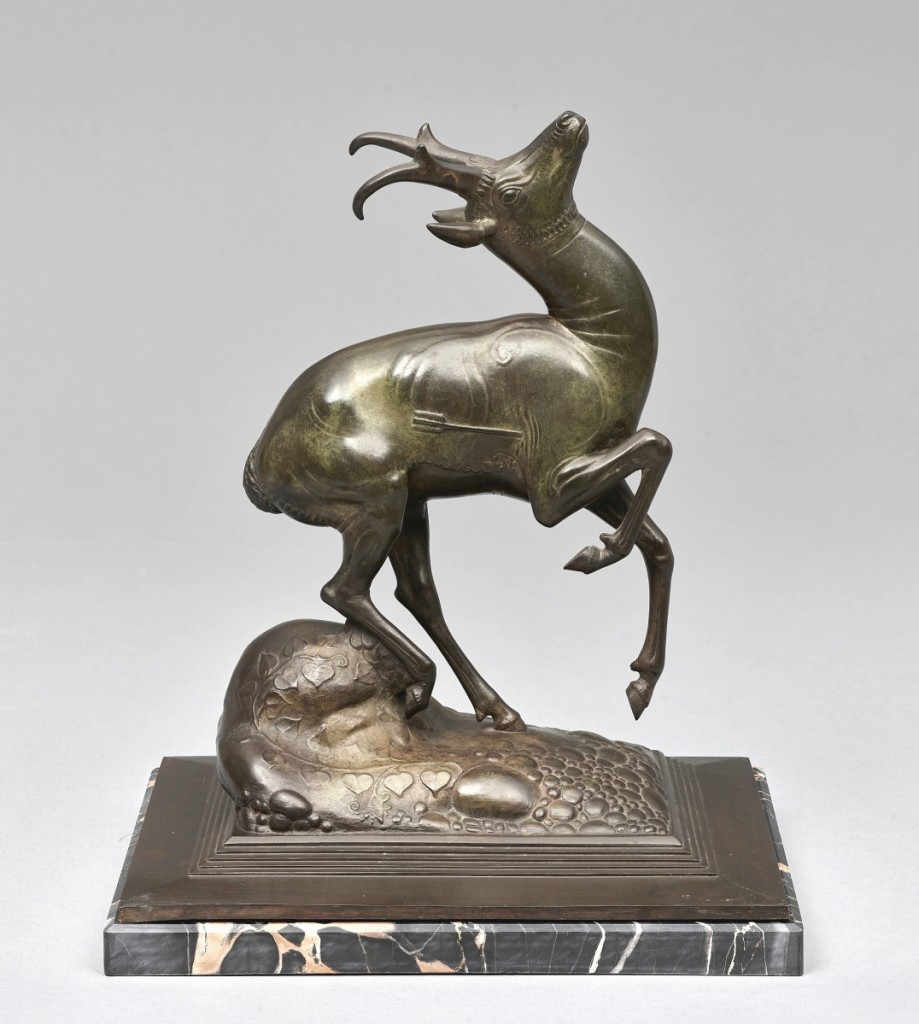
Paul Manship, “Indian,” 1914. Bronze, black-brown patina. Wadsworth Atheneum Museum of Art, Bequest of Honora C. Robertson. ©Estate of Paul Manship.
HARTFORD, CONN. – One of the most celebrated American sculptors of the early Twentieth Century, Paul Manship (1885-1966) blended ancient motifs to fit modern sensibilities. After studying at the American Academy in Rome (1909-12), Manship returned to New York City, where his dramatic, energetic works in bronze reinterpreted forms, stories and styles of the past for the modern American age. His streamlined, Art Deco style, and ability to represent his subjects at peak moments of drama attracted critical acclaim, particularly in the 1920s and 1930s. Seen together in this exhibition, his signature bronzes and associated sketches paired with ancient artifacts illuminate how Manship became a master of sampling imagery and melding disparate visual elements from multiple cultural traditions. “Today we call this a mash-up,” says Erin Monroe, Robert H. Schutz Jr, associate curator of American Paintings and Sculpture at the Wadsworth. “It’s a practice that has permeated popular culture, in music, fashion and the visual arts, for example.” “Paul Manship: Ancient Made Modern,” the first museum exhibition in 30 years and novel in its examination of this aspect of the artist’s work, will be on view to July 3, at the Wadsworth Atheneum Museum of Art.
Organized into three themes, the exhibition examines the influence of the art of the past, on Manship’s Twentieth Century modern style. “Breaking Through in Bronze” looks at Manship’s foundational years studying in Italy after winning a prestigious Rome Prize. His artistic path can be rooted in this significant time in his life.
Several important loans from the Minnesota Museum of American Art in St Paul, Minn., the artist’s hometown, tell the story of his early mastery of bronze, a medium that would define his career. One of the loans, a 1912 sketch of a frieze from the Treasury of Siphnians, in Delphi, reveals an interest in pattern and ornament evident in one of his first fully realized bronzes, the Wadsworth’s “Centaur and Dryad” (1913). Early sculptures and drawings by Manship are interspersed with ancient artifacts representative of those he closely studied during his three years in Rome and on later travels throughout the Mediterranean, Europe and Egypt. The form of a Cypriote statue of a standing man, the narrative and ornamental details from Greek vessels such as an oil flask (circa 475-460 BCE), and low-relief carving style inspired by an Assyrian relief fragment from the Palace of Ashurnasirpal II (883-859 BCE), all found their way into Manship’s sculptures.

Paul Manship, “Pronghorn Antelope,” 1914. Bronze, black-brown patina. Wadsworth Atheneum Museum of Art, Purchased through the gift of Henry and Walter Keney and the Krieble Family Fund for American Art. ©Estate of Paul Manship.
“Modernizing Mythology” explores Manship’s affinity for mythological subjects, and his unique way of illuminating age-old storylines. Examples of Manship’s captivating bronze sculptures are displayed adjacent to large-scale architectural designs, representing his ability to work on projects of varying scale. Statuettes such as the beautifully silhouetted “Flight of Night” (1916) possess a sense of movement. A series of panels from the American Telephone and Telegraph Building in Lower Manhattan (commissioned in 1914; installed in 1921) feature voluptuous, muscular male and female figures that blend elements of Asian and Ancient art. Floating in dreamlike realms, the accents of gold and carved ornamentation fuse a multicultural aesthetic into a glitzy, modern Art Deco design.
“Art for the Public” presents works Manship made at the height of his career connecting them to today’s conversations about urban design and beautification of public spaces. Widely known for two major projects of the 1930s – Prometheus in Rockefeller Center and the Paul Rainey Memorial Gates at the Bronx Zoo – this is the point in Manship’s career when he took on civic projects of grand ambition. The legacy of the iconic Prometheus sculpture is explored through archival photographs and a petite 7-inch gilded maquette (1933), a rare surviving model for the heroic scale work. The Wadsworth’s “Great Horned Owl” represents Manship’s animalier work as seen in his design of the Rainey Memorial Gates.
Visitors will have the opportunity to learn about Manship’s artistic process and materials, through a drawing prompt highlighting how the act of drawing was fundamental in Manship’s training as a sculptor. Plaster casts such as Euthydikos’ Kore (maiden), circa 490 BCE (after the marble original in the Acropolis Museum in Athens) exemplify the works Manship sketched in person, as shown in his drawing of a similar archaic statue Peplos Kore, from the Acropolis, 1924. These sketches and studies also underscore the influence of Manship’s travels to classical and ancient sites in Italy, Greece, and Egypt. In addition, archival views of Manship in his studio are displayed alongside his sculpting tools borrowed from the Manship Artists Residency + Studios, in Gloucester, Mass.
The Wadsworth Atheneum Museum of Art is at 600 Main Street. For information, 860-278-2670 or www.thewadsworth.org.













